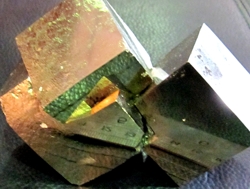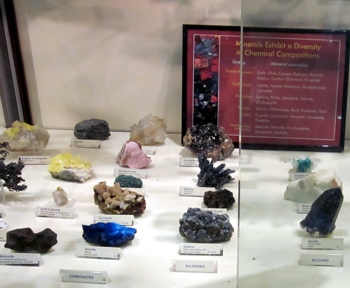 |
 |

Pyrite, Spain. Specimen donated to MHM by Roger Staley.
Minerals Heritage Museum
Display location:
Queensland Museum
Southbank, Brisbane, Queensland, Australia
(Mezzanine Floor)
Display Hours:
Open daily from 9.30am - 5.00pm.
Closed Good Friday, Christmas Day & Boxing Day. Open ANZAC Day from
1.30 pm.
General admission: Free.
| What
is a mineral Diversity of composition Diversity of crystal form Collecting minerals Australian minerals Overseas minerals Quartz group minerals Gem minerals |
 |
Four mineral posters for your wall featuring great mineral specimens from the MHM collection!
|
The Minerals Heritage Museum display is roughly divided into sections to help place the specimens into context. Because space in our display cabinets is quite limited, we intend to expand on the display information to include more detailed information in the form of fact sheets. These will be print-ready in pdf format and contain useful facts, information and images of minerals. We hope to add to these to build a useful resource for collectors and students.

MHM display illustrating diversity of
crystal systems.
What
is a mineral?
Minerals are the building blocks of rocks (which can be made up of many different minerals).
Minerals are inorganic, and have a discrete chemical composition, physical properties and crystal structure. There are over 5,000
minerals that have been discovered so far.
Minerals are found in the earth or are naturally occurring substances. (Minerals can also come from space, as minerals are
also found in meteorites). Minerals can be found in dirt, rocks, and even water.
Minerals are chemical substances. Some minerals like gold or silver consist of a single element only, however, most minerals such as quartz or calcite, are combinations of two or more elements.
Each mineral has its own same chemical composition. For example, quartz will always consist of one part silicon (Si) and two parts oxygen (O) to form
SiO2. Different minerals can have the same composition, but form different minerals, because the atoms of the elements that they are built from are arranged in a different crystal structure. Diamond and graphite are good examples of this - both are made
from pure Carbon (C), however, their crystal structure determines which mineral they form and their different physical properties.
Minerals are usually solid crystals. They have a number of flat surfaces in an orderly arrangement which form crystals. For example, a crystal of quartz is always hexagonal because of the way atoms of silicon and oxygen arrange themselves together.
Oxygen is part of many minerals. Minerals containing oxygen make up almost half of the earth's crust. Quartz is a common mineral. Other common minerals are feldspar, mica, and horneblend. Many rocks are made of these common minerals.
To identify a mineral we compare the specimen's properties with those of known minerals to identify it. These include colour, lustre, streak, cleavage, hardness, specific gravity, crystal shape and chemical composition. It is unusual to find a new mineral, but 20 or 30 new minerals are discovered each year!
Diversity
of composition
Minerals exhibit a diversity of chemical compositions, and a few consist
of single elements only. Most are combinations of elements and these are
arranged under the dominant element group.
| Group | Examples of minerals in our display |
| Native elements: | Gold, Silver, Copper, Platinum, Bismuth, Sulphur, Carbon (Diamond, Graphite) |
| Carbonates: | Calcite, Azurite, Malachite, Rhodochrosite, Cerussite |
| Sulphides: | Galena,
Pyrite, Sphalerite, Stibnite, Chalcopyrite |
| Silicates: | Quartz, Orthorclase, Beryl, Dioptase, Opal |
| Oxides: | Cuprite,
Corundum, Hematite, Cassiterite, Goethite |
| Vanadinates/Arsenates: | Adamite, Mimetite, Pyromorphite, Vanadinite, Erythrite |
Diversity
of crystal form
Minerals exhibit a diversity of crystal forms, and these minerals are
arranged in groups that all exhibit the same internal structure of their elements
and external crystal forms:
| Crystal system | Examples of minerals in our display |
| Cubic: | Pyrite, Fluorite, Garnet Group |
| Tetragonal: | Cassiterite, Wulfenite, Zircon |
| Trigonal: | Calcite, Corundum, Tourmaline Group |
| Hexagonal: | Beryl, Quartz |
| Orthorhombic: | Barite, Celestite, Fluorapatite |
| Monoclinic: | Gypsum, Crocoite, Azurite |
| Triclinic: | Microcline, Kyanite, Rhodonite |
 |
Download a diagram of minerals and different crystal forms (PDF 170KB) |
Collecting
minerals - Where can I find mineral specimens?
Minerals in finely crystallised forms, such as those displayed at the MHM,
are rare in nature. Many have come from working mines. However, many beautiful specimens still can be found once you know where to look! Specimens in
our display have come from such varied sources as a canal estate under construction in Redcliffe, and
the Toowoomba landfill site! Old quarries and mine sites are popular fossicking spots. Anywhere freshly disturbed rock occurs is a good start, but be sure to make sure that you have permissions. Mineralogical societies and lapidary clubs are also a great help to start
collecting as a past time.
Australian
minerals
Minerals have been a major factor contributing to Australia’s growth since white settlement in 1788. The discovery of large deposits of gold, silver and copper in the 1800’s created enormous wealth and population growth throughout the colony. Mineral exploration and subsequent mining created large inland towns such as Kalgoorlie, Broken Hill, Cloncurry and Mount Isa. Mining of these deposits also unearthed many wonderful mineral specimens. Australia is home to a number of unique minerals and to some which are the best of their species.
Overseas
minerals
The quirks of nature ensure that minerals are not evenly scattered across the globe. To ensure a balanced, high quality collection, overseas mineral specimens are included in the MHM collection. Localities or mines become synonymous with particular mineral species due to the abundance or perfection of minerals at that site. Curators and collectors strive to display the best pieces that show perfection of crystallisation, size, colour, rarity and aesthetics. Many of these overseas specimens occur only rarely in Australia, or are not of such high quality.
Quartz
group minerals
Quartz (silicon dioxide or SiO2) is one of the most common compounds found on the surface of the earth. It is the major component of beach sands. However, it also forms beautiful mineral specimens in a huge variety of forms and colours that are particularly valued by collectors. In crystalline forms it is used as a semi-precious stone in jewellery such as amethyst, citrine and smoky quartz. When micro-crystalline it forms agate, onyx and other
chalcedonies. Amorphous silica forms our national gem, the opal. Quartz can be the basis for an entire collection!
Gem
minerals - Precious and semi precious minerals
A small group of minerals have been valued by mankind since the beginnings of civilisation. Gem minerals exhibit unusual beauty combined with durability and rarity. At first, natural crystals were worn as an adornment. Over time, artisans developed cutting processes to highlight the colour and reflective properties of these select minerals. Large, naturally coloured gems are very highly valued. Today, many of the stones seen in jewellery stores are merely synthetic imitations or treated examples of many naturally occurring minerals.
~
Preserving Australia's Mineral Heritage ~
Copyright MHM 2015 -
The Minerals Heritage Museum is a not-for-profit institution
based in Brisbane.
